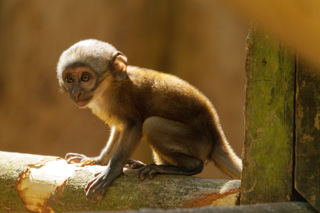
L’Hoest’s monkey
The L’Hoest’s monkey is found in tropical rainforests of Africa. It has a white ruff that frames the face with distinctive deep set orange eyes. Their bodies are black and have long legs which are grizzled with grey. They have a chestnut coloured “saddle” at the base of their back. Their long tails are thick at the base and brush-like towards the end. Males can grow to be twice the weight of females and are easily recognised by their bright blue scrotum.

L’Hoest’s monkeys have a more terrestrial lifestyle compared to most monkeys. They will live in groups with one adult male and form close bonds that are reinforced through mutual grooming. When feeding and sleeping, L’Hoest’s monkeys will move higher into the trees and individuals will have favourite sleeping spots.

Females will usually give birth to a single infant every other year, after a five month gestation period. These infants are born with brown fur that develops into adult colours by three months old. Weaning occurs at around one year old and once the males reach sexual maturity they leave the group.
Fruits, leaves and invertebrates make up the majority of the L’Hoest’s monkeys diet.
Populations of L’Hoest’s monkeys are decreasing due to deforestation from agricultural development and hunting. They are listed as Vulnerable on the IUCN Red List of Threatened Species.
Key Facts:
Conservation Status: Vulnerable
Distribution: Central Africa
Habitat: Tropical Forest
Diet: Flowers, Fruit, Insects, Leaves, Seeds
Height: 45 – 70cm
Weight: 4 – 8kg
Gestation: 5 months
No. of young: 1
Life Span: 20 years

SUPPORT OUR ANIMALS
If you're looking for an alternative way to donate to Twycross Zoo, you can help support our animals and our zoo keepers by purchasing something from our Amazon Wishlist!
Updated regularly by our zoo keepers, the items on the list help to provide enrichment for our animals and keep their habitats well maintained.
Every donation helps us as a conservation charity.
